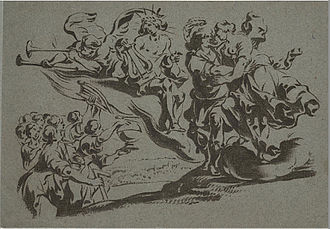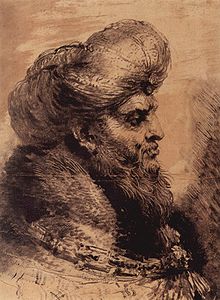Monotyping

Monotyping is a type of
Monotyping produces a unique print, or monotype; most of the ink is removed during the initial pressing. Although subsequent reprintings are sometimes possible, they differ greatly from the first print and are generally considered inferior. These prints from the original plate are called "ghost prints." A print made by pressing a new print onto another surface, effectively making the print into a plate, is called a "cognate".
History

There is still no certainty as to who was the inventor of the monotype process. The Italian artist
Comparing monotypes to monoprints
Historically, the terms monotype and monoprint were often used interchangeably.[10] More recently, however, they have come to refer to two different, though similar, types of printmaking. Both involve the transfer of ink from a plate to the paper, canvas, or other surface that will ultimately hold the work of art. In the case of monotypes, the plate is a featureless plate. It contains no features that will impart any definition to successive prints. The most common feature would be the etched or engraved line on a metal plate. In the absence of any permanent features on the surface of the plate, all articulation of imagery is dependent on one unique inking, resulting in one unique print. Additionally, the term monotype is often used for an image made by inking a non-absorbent surface with a solid colour, laying over it a piece of paper and drawing onto the back of the paper. When the paper is pulled off the resulting print consists of the line surrounded by ink picked up from the inked plate. The result has a chance element, often random and irregular which gives the print a certain charm, a technique famously used by British artist Tracey Emin, a graduate of the Royal College of Art, where the practice of monoprinting in general was regarded as "fake painting".
Monoprints, on the other hand, now refers to the results of plates that have permanent features on them. Monoprints can be thought of as variations on a theme, with the theme resulting from some permanent features being found on the plate—lines, textures—that persist from print to print. Variations are confined to those resulting from how the plate is inked prior to each print. The variations are endless, but certain permanent features on the plate will tend to persist from one print to the next.

See also
References
- ISBN 0-7141-2608-X
- ^ Todd D. Weyman, Two Early Monotypes by Sallaert, in: Print Quarterly Vol. 12, No. 2 (JUNE 1995), p. 164-169
- ^ M. Royalton Kisch, A Monotype by Sallaert, in: Print Quarterly, 1988, V, n. 1, p. 60-61
- ^ Kelley Notaro, An Exhibition of the Finest Monotypes from the Cleveland Museum of Art's Collection at The Cleveland Museum of Art site
- ^ Marc Chagall Monotypes, Gerald Cramer, Editor, Geneva 1966
- ^ "Roman Turovsky > Work > Monoprints".
- ^ "Monotype". www.moma.org. Retrieved 2020-05-14.
- ^ "Forward Press: 21st Century Printmaking". American University. Retrieved 2020-05-14.
- ^ "Virginia Groot Foundation 2005 Winners".
- ^ Singular impressions: the monotype in America. Joann Moser. Smithsonian Institution Press, 1997.
Sources
- Reed, Sue Welsh & Wallace, Richard, Italian Etchers of the Renaissance and Baroque, Museum of Fine Arts, Boston 1989,pp 262–5,ISBN 0-87846-306-2or 304-4 (pb)
External links
 Media related to Monotypes at Wikimedia Commons
Media related to Monotypes at Wikimedia Commons- Video explaining the monotype process
